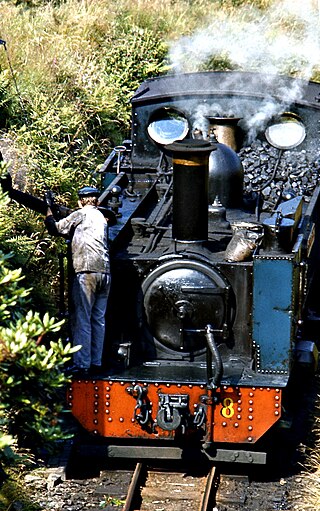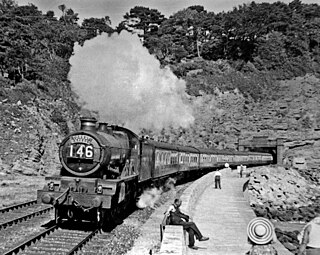
The LNER Class A4 is a class of streamlined 4-6-2 steam locomotive designed by Nigel Gresley for the London and North Eastern Railway in 1935. Their streamlined design gave them high-speed capability as well as making them instantly recognisable, and one of the class, 4468 Mallard, holds the record as the world's fastest steam locomotive. Thirty-five of the class were built to haul express passenger trains on the East Coast Main Line route from London Kings Cross via York to Newcastle, and later via Newcastle to Edinburgh, Scotland. They remained in service on the East Coast Main Line until the early 1960s when they were replaced by Deltic diesel locomotives; they themselves proving to be worthy successors to the A4s. Several A4s saw out their remaining days until 1966 in Scotland, particularly on the Aberdeen – Glasgow express trains, for which they were used to improve the timing from 3.5 to 3 hours.

The 4073 or Castle Class are 4-6-0 steam locomotives of the Great Western Railway, built between 1923 and 1950. They were designed by the railway's Chief Mechanical Engineer, Charles Collett, for working the company's express passenger trains. They could reach speeds of up to 100 mph (160 km/h).

The London, Midland and Scottish Railway (LMS) Coronation Class is a class of express passenger steam locomotives designed by William Stanier. They were an enlarged and improved version of his previous design, the LMS Princess Royal Class, and on test were the most powerful steam locomotives ever used in Britain at 2,511 dbhp. The locomotives were specifically designed for power as it was intended to use them on express services between London Euston and Glasgow Central; their duties were to include the hauling of a proposed non-stop express, subsequently named the Coronation Scot.

LNER Class A4 4468 Mallard is a 4-6-2 ("Pacific") steam locomotive built in 1938 for operation on the London and North Eastern Railway (LNER) at Doncaster Works to a design of Nigel Gresley. Its streamlined, wind tunnel tested design allowed it to haul long distance express passenger services at high speeds. On 3 July 1938, Mallard broke the world speed record for steam locomotives at 126 mph (203 km/h), which still stands today.

The steam locomotives of British Railways were used by British Railways over the period 1948–1968. The vast majority of these were inherited from its four constituent companies, the "Big Four".

The British Rail Class 98 is a Total Operations Processing System (TOPS) classification that has been used to cover all steam locomotives used on the mainline in Britain, but also has a particular usage for the three Vale of Rheidol Railway-design 2-6-2T locomotives that remained in the ownership of British Rail (BR) after the end of mainline steam traction in August 1968. The locomotives on the Vale of Rheidol Railway were the only steam locomotives ever officially to carry the British Rail corporate blue and the double arrow logo.

The BR Standard Class 7, otherwise known as the Britannia Class, is a class of 4-6-2 Pacific steam locomotive designed under Robert Riddles for use by British Railways for mixed-traffic duties. 55 were constructed between 1951 and 1954. The design employed results from the 1948 locomotive exchanges undertaken in advance of further locomotive classes being constructed. Three batches were constructed at Crewe Works, before the publication of the 1955 Modernisation Plan.

The London, Midland and Scottish Railway (LMS) Stanier Class 8F is a class of steam locomotives designed for hauling heavy freight. 852 were built between 1935 and 1946, as a freight version of William Stanier's successful Black Five, and the class saw extensive service overseas during and after the Second World War.

The London, Midland and Scottish Railway (LMS) Royal Scot Class is a class of 4-6-0 express passenger locomotive introduced in 1927. Originally having parallel boilers, all members were later rebuilt with tapered type 2A boilers, and were in effect two classes.

The Torbay Express is a named passenger train operating in the United Kingdom.

LMS Royal Scot Class 6115 Scots Guardsman is a preserved British steam locomotive. Built by the London, Midland and Scottish Railway (LMS) as a member of the Royal Scot Class, it was later operated by British Railways.
The history of rail transport in Great Britain 1923–1947 covers the period when the British railway system was run by the Big Four group of companies – the London, Midland and Scottish Railway (LMS); the Great Western Railway (GWR); the London and North Eastern Railway (LNER); and the Southern Railway (SR). The period includes the investment following World War I; the rise in competition from the roads in the 1920s; development of steam locomotives capable of sustained 100 mph (160 km/h) running; the Great Depression of the 1930s; World War II and its aftermath; and the lead up to nationalisation during 1947.
The Coronation was a streamlined express passenger train run by the London and North Eastern Railway between London King's Cross and Edinburgh Waverley. Named to mark the coronation of King George VI and Queen Elizabeth, it was inaugurated on 5 July 1937. The down train (northbound) left London at 4 pm and arrived in Edinburgh at 10 pm; the up train (southbound) ran half an hour later.

The cylinder is the power-producing element of the steam engine powering a steam locomotive. The cylinder is made pressure-tight with end covers and a piston; a valve distributes the steam to the ends of the cylinder. Cylinders were initially cast iron, but later made of steel. The cylinder casting includes other features such as valve ports and mounting feet. The last big American locomotives incorporated the cylinders as part of huge one-piece steel castings that were the main frame of the locomotive. Renewable wearing surfaces were needed inside the cylinders and provided by cast-iron bushings.
The South Devon Banks are a series of steep inclines on the ex-GWR railway line linking Exeter and Plymouth in Devon, England. These two cities are separated by the rocky uplands of Dartmoor forcing the early railway surveyors to propose that the line skirt the difficult terrain of the comparatively sparsely populated moorland. Isambard Kingdom Brunel, in surveying the South Devon Railway, opted to push a line along a coastal strip between the Exe and Teign valleys, and then to climb the southern outliers of Dartmoor making for the head of the Plym estuary. From Newton Abbot, the line climbs Dainton Bank, and from Totnes it climbs Rattery Bank, reaches a peak at Wrangaton summit, and then descends Hemerdon Bank to reach Plymouth. These three are collectively known as the South Devon Banks.

Rosebud Kitmaster is the brand name of a short-lived but critically acclaimed range of plastic assembly kits, manufactured in the United Kingdom by Rosebud Dolls Ltd of Raunds, Northamptonshire. Introduced from May 1959, the range rapidly expanded to include 34 models of railway locomotives and coaches in OO, HO and TT scales, and eventually, one motorcycle in 1:16 scale.

LNER Class A4 4902 Seagull was one of 35 Doncaster built LNER Class A4 Gresley Pacific steam locomotives.
Lillian "Curly" Lawrence, known as LBSC, was one of Britain's most prolific and well known model or scale-steam-locomotive designers. LBSC were the initials of Britain's London, Brighton and South Coast Railway, where he was once employed as a fireman.

LNER Class A3 2750 Papyrus was a 4-6-2 "Pacific" steam locomotive built for the London and North Eastern Railway (LNER) at Doncaster Works to a design of Nigel Gresley, entering service in March 1929. Primarily used to haul express passenger trains on the East Coast Main Line by LNER and its successor, British Railways, it is notable for achieving what was at the time a world record-breaking speed for a steam locomotive of 108 mph on 5 March, 1935. A fictionalized account based on the locomotive's service history and speed record, 2750: Legend of a Locomotive by H.C. Webster, was published in 1953 and reprinted in 2016.

















